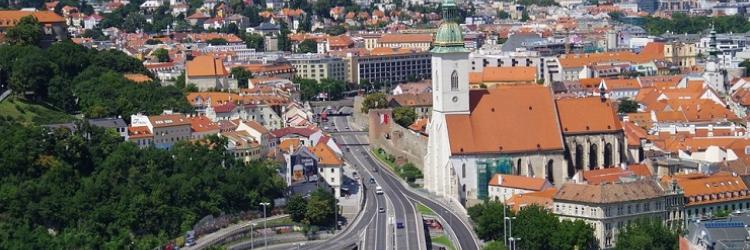Other Comments: 0 May 29, 2017
Bratislava, the capital of Slovakia, lies along the Danube River. Surrounded by vineyards and the Little Carpathian mountains, this destination is like a heaven for those who enjoy hiking and cycling, thanks to its numerous trails and roads. Those who prefer the atmosphere of the hustle and bustle of the city, this pedestrian-only, 18th-century old town will captivate everyone its lively bars and cafes. Bratislava is the choice of thousands of tourists every year who come to admire its wonderful Old Town and buildings with an architecture of numerous styles standing silently next to each other. Beside the fact that Bratislava is in vicinity of the capital of Austria, Vienna, it is also the only capital city in the world bordering two independent countries – Austria and Hungary.
Bratislava Castle or Hrad sits proudly on a hill overlooking the city. Back in its history it used to serve as a Roman frontier post, with the castle dating since the 9th century. In 1881, the castle was reduced to rubble due to a fire. The reconstrucation began in the mid 1900s. Nowadays, the castle resembles an upside down table with four corner towers that look like table legs. Despite its weird exterior, the castle houses numerous museums, where the numerous rooms of The History Museum and the National Museum Are definitely worth to visit. Other rooms are dedicated to colourful Slovakian glassware, clocks carved wooden furniture, helmets, weapons, and armor. There is a mesmerizing display of silver bowls, plates and utensils dating from the 17th to 19th century. A special part belongs to a Renaissance jewel chest, from circa 1600, as well as a replica of the crown of the Hungarian kings. The steep flight of stairs beginning from this site lead to the Crown Tower, a small enclosed tower owith a 360 degree view of the city.
St. Martin’s Cathedral - This ancient cathedral lies on the very edge of the Old Town, and is regarded as Bratislava’s foremost Gothic structure. The church, built in the Romanesque style, dates back from the 13th century, but was replaced by a 3-nave Gothic Dome in the late 14th century. The new St. Martin's Cathedral was consecrated in 1452, and it went through plenty of lengthy reconstructions in centuries to come. In the 16th century, the Dome became the coronation church of all 19 Hungarian Emperors, and there were 19 Hungarian Emperors until the 19th century(including Maria Theresia).
The cathedral is famous for its works of art, especially an 18th century statue of St. Martin and the Beggar by Austrian baroque sculptor Raphael Donner. Nothing short of admiration is St. Stephen's Crown, a 1m high copy of the Hungarian royal crown perched upon the church tower, some 85 meters above town.
Primatial Palace - the Palace that dates from 1778 and is situated in the bustling centre of Old Town is considered as one the most beautiful building in Bratislava. The pale pink and white color of its exterior, decorated with marble statues and a large cast iron cardinal’s hat, the symbol of the Archbishop to whom the very palace was dedicated, attracts a lot of tourists. The palace can be proud of its invaluable oil portraits of Hapsburg royalty, including one from 1742 of Marie Therese at her coronation. Individual rooms, which are very scarce in furniture, have enormous sparking crystal chandeliers, and the scarcity of the furniture makes them even more prominent. Also, once hidden in the palace and discovered in 1900s during the renovation process, sic English tapestries dating from the 17th century adorn the walls of the rooms.
Another major attraction of historical significance in the palace is the ornate Hall of Mirrors. It was the place of negotiations and the place where the Treaty of Pressberg (Pressberg was Bratislava’s former name) was signed by Napoleon and Francis I in 1805 in the wake of the Battle of Austerlitz, where 50,000 Russian, French and Austrian soldiers lost their lives.
St. Elisabeth’s Church - This church is regarded as the most beautiful pieces of Art Nouveau architecture in the world. Also known as the Blue Little Church. it was built in the period from 1907-1913, following the design of Hungarian architect Odon Lechner. The Blue Church, featuring one nave and a cylindrical tower , and with its exterior design built in the Hungarian Art Nouveau style and ornated with bright and beautiful blue majolica tiles, is a breathtaking sight
Grassalkovich Palace, also known as the Presidental Palace, was once the home and meeting place for several members of the Austro-Hungarian and Habsburg aristocracy. It was built in the 1760's by Count Anton Grassalkovich, the President of the Royal Hungarian Chamber and advisor to the Empress Maria Theresia. While visiting the Grassalkovich Palace an honour guard can be seen marching in front of the castle, guarding it 24 hours a day. Grassalkovich Palace is also famous for its Baroque garden that is open to the public, even when the President is in residence.
Devin Castle, the ancient building situated above the confluence of the rivers Danube and Morava, is known to be as one of the three oldest historically acknowledged castles in Slovakia. The village of Devin, dating from the 5th century B.C and that was once populated by Celts and was an important trade center on the Danube thanks to its suitable position, is now a part of Bratislava. The castle played an important role under the Roman Empire as as a military station, besides being a trade center. The castle went through the alteration process in the 13th and 16th century, but was heavily damaged by Napoleon's troops in 1809. Devin Castle has been declared a National cultural monument since 1961 and serves as a museum today.
St. Michael's Gate and Street , one of the most popular Bratislava’s sights, is famous for its lively shops and restaurants and is a must when visiting the city. Most of the building on the Michael’s Street date from the 18th Century and have survived many wars, occupations, and Communist rule, which was notorious for tearing down old, historic buildings throughout then-Czechoslovakia and replacing them with unattractive cell-block like high-rise apartments.
On the top of the street there is St. Michael's Gate - the only one that was preserved from the medieval city fortifications. The foundations of the gate were laid in the first half of the 14th century. It got its current appearance during 1753 – 1758 , together with a statue of St. Michael.
Bridge of Slovak National Uprising (UFO Bridge) -The bridge of Slovak National Uprising was built between years 1967 and 1972. Even though during its construction, a major part of the Old Town of Bratislava, including the historically valuable parts Vydrica and synagogue in Moorish style, had to be demolished for its sake. the bridge has been beneficial for the acceleration of the traffic to the residential area of Petržalka, thus contributing to the development of the housing estate. A special attraction is a restaurant and a terrace which offers a panoramic view from the top of the bridge, known among tourists, as well as among locals, as “UFO” thanks to its shape.
Apollo Bridge, the state-of-the-art bridge across the Danube river in Bratislava, was built in 2002-2005. This bridge was the only European project nominated for the OPAL Award by the American Society of Civil Engineers in 2006, and besides the nomination, it actually won the top price. A sight to remember would be this bridge in the night, when it is illuminated with various specters of colored lights.


 RS
RS  ME
ME  HR
HR  BA
BA  RU
RU  MK
MK  AL
AL  ES
ES  DE
DE  IT
IT  CN
CN  NL
NL  SE
SE  FR
FR 






Write a comment